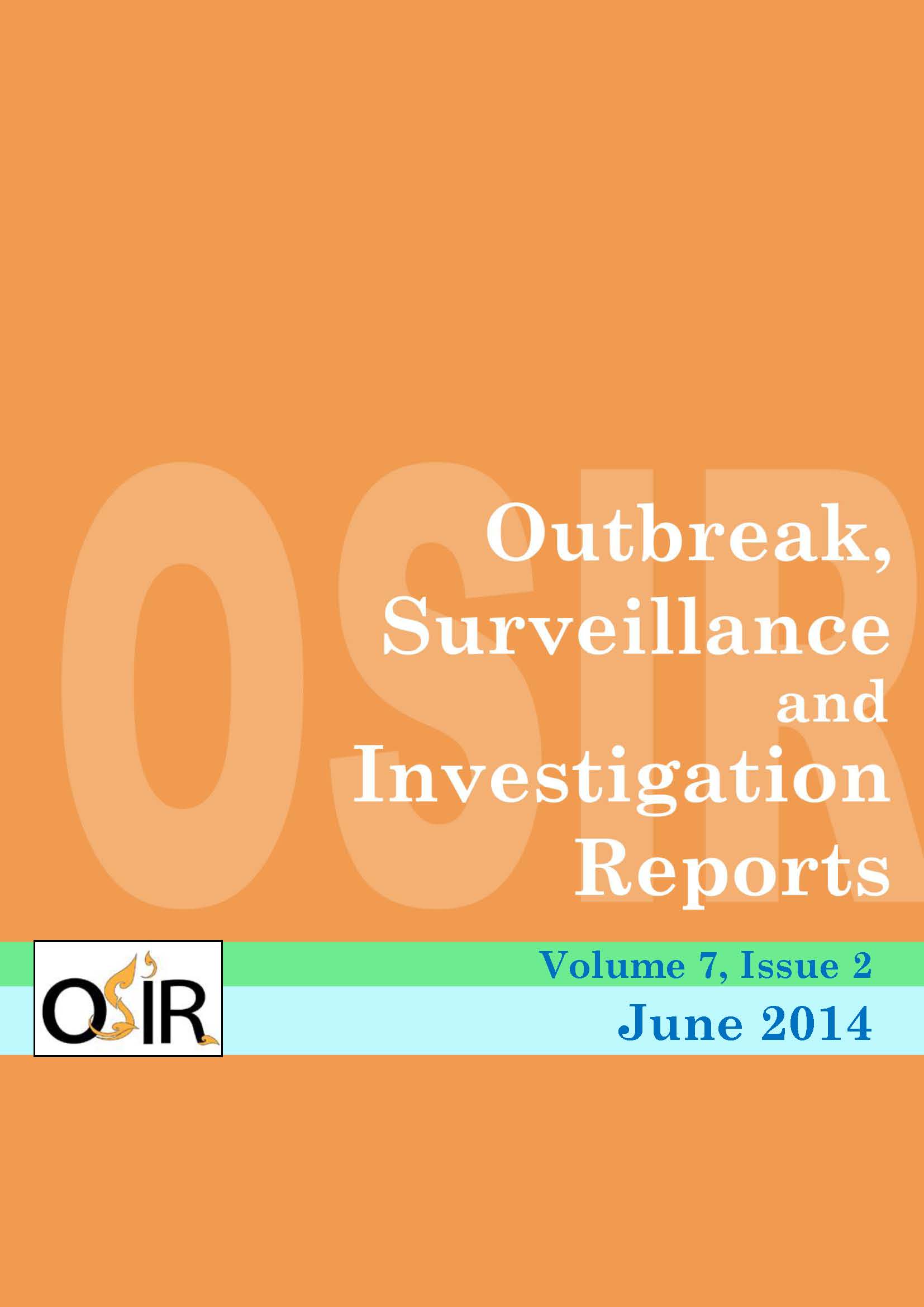Investigation of Highly Pathogenic Avian Influenza (H5N1) Outbreaks among Poultry in Ningxia, China, 2012
DOI:
https://doi.org/10.59096/osir.v7i2.263291Keywords:
HPAI, H5N1, outbreak investigation, poultry layerAbstract
In April 2012, there were reports of suspected highly pathogenic avian influenza (HPAI) H5N1 among poultry layers in Ningxia. A retrospective investigation was conducted to describe epidemiological characteristics of the outbreak and identify risk factors for HPAI H5N1 infection. We administered a questionnaire to all 87 poultry layer farms in Touying County, Ningxia Province, within four weeks following the last reported outbreak. Samples of sick chickens were collected from 45 suspected farms to determine presence of H5N1 virus by reverse transcription polymerase chain reaction (RT-PCR) and confirmed by virus isolation. We used multiple logistic regression analysis to identify risk factors for infection and semivariogram analysis to demonstrate clustering of infected farms. Among 45 farms with positive PCR results, virus was isolated from four farms. Farms with improper waste disposal (Adjusted OR = 2.7, 95% CI = 1.20-8.30) and having visitors in farm within the past month (OR = 5.5, 95% CI = 1.97-15.64) were significantly associated with HPAI infection. H5N1 was widespread in the county. Frequent human movement into farms and improper waste management increased the risk of infection. Biosecurity practices, including limiting number of visitors and proper waste disposal, should be enhanced to prevent further H5N1 infection.
References
Williams RA, Peterson AT. Ecology and geography of avian influenza (HPAI H5N1) transmission in the Middle East and northeastern Africa. Int J Health Geogr. 2009 Jul 20;8:47.
Zhang Z, Chen D, Chen Y, Liu W, Wang L, Zhao F, et al. Spatio-temporal data comparisons for global highly pathogenic avian influenza (HPAI) H5N1 outbreaks. PLoS One. 2010 Dec 20;5(12):e15314.
Li Y, Shi J, Zhong G, Deng G, Tian G, Ge J, et al. Continued evolution of H5N1 influenza viruses in wild birds, domestic poultry, and humans in China from 2004 to 2009. J Virol. 2010 Sep;84(17):8389-97.
Chen J, Fang F, Yang Z, Liu X, Zhang H, Zhang Z, et al. Characterization of highly pathogenic H5N1 avian influenza viruses isolated from poultry markets in central China. Virus Res. 2009 Dec;146(1-2):19-28. Epub 2009 Aug 29.
Tian G, Zeng X, Li Y, Shi J, Chen H. Protective efficacy of the H5 inactivated vaccine against different highly pathogenic H5N1 avian influenza viruses isolated in China and Vietnam. Avian Dis 2010 Mar;54(1 Suppl):287-9.
Connie Leung YH, Luk G, Sia SF, Wu YO, Ho CK, Chow KC, et al. Experimental challenge of chicken vaccinated with commercially available H5 vaccines reveals loss of protection to some highly pathogenic avian influenza H5N1 strains circulating in Hong Kong/China. Vaccine. 2013 Aug 2;31(35):3536-42. Epub 2013 Jun 19.
Zou W, Ke J, Zhu J, Zhou H, Jin M. The antigenic property of the H5N1 avian influenza viruses isolated in central China. Virol J. 2012 Aug 6;9:148.
Liu H, Wang X, Wang J, Zhao Y, Zheng D, Chen J, et al. Genome sequences of an H5N1 highly pathogenic avian influenza virus isolated from vaccinated layers in China in 2012. Genome Announc. 2013 Nov-Dec;1(6): e00936-13.
Cressie N. Statistics for spatial data. New York: Wiley; 1993.
Gu M, Huang J, Chen Y, Chen J, Wang X, Liu X. Genome sequence of a natural reassortant H5N2 avian influenza virus from domestic mallard ducks in eastern China. J Virol. 2012 Nov;86(22):12463-4.
Zhao G, Gu X, Lu X, Pan J, Duan Z, Zhao K, et al. Novel reassortant highly pathogenic H5N2 avian influenza viruses in poultry in China. PLoS One. 2012 Sep 25;7(9):e46183.
Zhao K, Gu M, Zhong L, Duan Z, Zhang Y, Zhu Y, et al. Characterization of three H5N5 and one H5N8 highly pathogenic avian influenza viruses in China. Vet Microbiol. 2013 May 3;163(3-4):351-7. Epub 2013 Jan 17.
Zhao S, Suo L, Jin M. Genetic characterization of a novel recombinant H5N2 avian influenza virus isolated from chickens in Tibet. J Virol. 2012 Dec;86(24):13836-7.
Downloads
Published
How to Cite
Issue
Section
License
Copyright (c) 2023 Outbreak, Surveillance, Investigation & Response (OSIR) Journal

This work is licensed under a Creative Commons Attribution-NonCommercial-NoDerivatives 4.0 International License.









